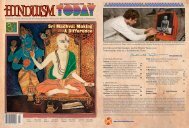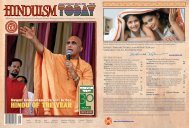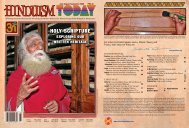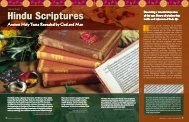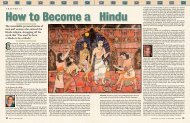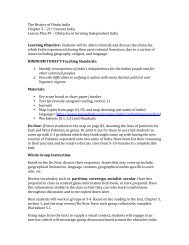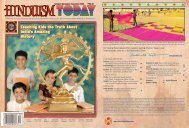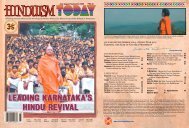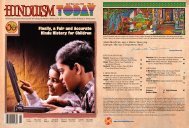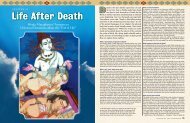chapter 11 - Hinduism Today Magazine
chapter 11 - Hinduism Today Magazine
chapter 11 - Hinduism Today Magazine
- No tags were found...
Create successful ePaper yourself
Turn your PDF publications into a flip-book with our unique Google optimized e-Paper software.
<strong>chapter</strong> <strong>11</strong>A Creed ofMonasticismSwami Vivekananda’s“Song of theSannyasin”Boldly Definesthe Ideals ofMonastic Lifea. manivelSteadfastnesse: In the painting atleft a young sadhu sits near a river,recalling his choice in life (depictedin the scene behind him) betweenbeing a solitary monk (left) and amarried man (right). In the phototo the right, ashramites at theBAPS Sarangpur Sadhu schoollisten in rapt attention to SivayaSubramuniyaswami’s wisdomregarding monastic life during agathering in 1995.hinduism todayThere was a time, not too long ago, when childrenand young men in India were taught that to renounce theworld in the quest for God realization, in service to God,was the noblest human path. Parents would explain toboys that sannyasa, the way of the renunciate monk, was open tothem. They would explain that, if they chose it, they would havethe greatest chance of knowing once and for all the divine purposeand Ultimate Truth of life. Hindu scriptures clearlyand abundantly proclaim sannyasa to be the highestdharma. But how many believe this anymore? Howmany parents encourage a child to consider sannyasaas a life pattern? How many young men honestly feelthey will be respected more for donning orange robesand serving God than for wearing a white smockand amassing money? Still, there are bastions ofhope. Notable are the Ramakrishna Mission and theSwaminarayan monastic orders—among India’s threemillion mendicants. But today, more and more, if oneproposed to Hindu parents that their son might become a swami,the response would be quiet disregard, indicating that “there aremuch better things the boy could do.”Swami Vivekananda held firm to the time-honored Hindu scripturalview of sannyasa. He lived it fully and experienced its everynuance. Yet, he is so revered for his latter few years—traveling andpromoting <strong>Hinduism</strong> in the West—that details of his ascetic lifeprior to his trip to America are not commonly recanted. PerhapsVivek ananda anticipated that renunciates might one day lose esteem,or perhaps he saw it happening in his lifetime, for, in 1895, duringa seven-week stay at Thousand Island Park, on the St. LawrenceRiver in New York State, he composed the eloquent “Song of theSacred transcript: A portion of the poem in Swamiji’s handSannyasin,” a 13-verse ode to the supremacy of renunciation.Vivekananda and his song have inspired many saints of this century.Sage Yogaswami of Sri Lanka was deeply touched by SwamiVivekananda’s public address given during a brief stay in Colomboin 1897. Vivekananda’s opening words, “The time is short and thesubject is vast,” impacted the young Yogaswami profoundly. Yogaswamiquoted the phrase like a mantra, endeavoring to impressupon devotees not to waste time in idle pursuits of the world, butimmediately begin working for their liberation from the cycle ofbirth and death.Satguru Sivaya Subramuniyaswami, Yogaswami’s successor, wasinfused with the urge to renounce the world upon reading “Song ofthe Sannyasin” when just a teenager.<strong>Today</strong> each of the hundreds of Ramakrishna monks glean inspirationand encouragement from this poem and by studying SwamiVivekananda’s life. But the song was not his only declaration onsannyasa’s supremacy. Swami is well known for saying, “Never forgetand teach to your children that as is the difference between a fireflyand the blazing sun, between the infinite ocean and a little pond,between a mustard seed and the mountain Meru, such is the differencebetween the householder and the sannyasin!”Vivekananda was arguably the most renowned Hindu spiritualleader of this century (even though he died in 1902 at the early age39). It is the spirit of his renunciation, and the profound wisdom andinsights into human experience gained from his dedicated life, thatthe “Song of the Sannyasin” presents in poetic beauty and compellingcommand.The remarkable philosopher-monk was only 32 years old at thetime of his visit to the Park, but he was already a celebrity in America.He had arrived in the United States two years earlier, in July1893, journeying from India to Chicago at the urging of his fellowmonks and admirers to represent <strong>Hinduism</strong> at the World Parliamentof Religions. His humble yet electrifying address, at the endof an opening day of sectarian speeches, completely transformedthe tenor of the conference. The New York Herald noted: “He isundoubtedly the greatest figure in the parliament.”Exhausted by nearly two strenuous years of lecturing throughoutthe US, Vivekananda was grateful to find refuge at the Park. Feelingrejuvenated, he gathered his spiritual power to train the twelvestudents who followed him there. His thoughts and teachings weretranscribed into “Inspired Talks,” a compilation which merged thespirituality of Ramakrishna with Swamiji’s deep concern for thepolitical freedom and material well-being of humanity. Swami saidhe was “at his best’’ at Thousand Island Park. The ideas and visionshe refined and expressed there grew during later years into institutionsin India and elsewhere.Vivekananda’s song presents a bold message, one sorely needed intoday’s world. We present it here in honor of the Ramakrishna renunciates,and for all courageous youth who yet today dare to wonderif life may have more to offer. Here is assurance that it does.<strong>11</strong>6 what is hinduism?√ <strong>chapter</strong> <strong>11</strong>: a monk’s creed <strong>11</strong>7
Wake up the note! the song that had its birthFar off, where worldly taint could never reach,In mountain caves and glades of forest deep,Whose calm no sigh for lust or wealth or fameCould ever dare to break; where rolled the streamOf knowledge, truth, and bliss that follows both.Sing high that note, sannyasin bold! Say,“Om Tat Sat, Om!”Strike off thy fetters! bonds that bind thee down,Of shining gold, or darker, baser ore—Love, hate; good, bad; and all the dual throng.Know slave is slave, caressed or whipped, not free;For fetters, though of gold, are not less strong to bind.Then off with them, sannyasin bold! Say,“Om Tat Sat, Om!”Let darkness go, the will-o’-the-wisp that leadsWith blinking light to pile more gloom on gloom.This thirst for life forever quench; it dragsFrom birth to death, and death to birth, the soul.He conquers all who conquers self.Know this and never yield, sannyasin bold! Say,“Om Tat Sat, Om!”“Who sows must reap,” they say, “and cause must bringThe sure effect: good, good; bad, bad; and noneEscapes the law. But whoso wears a formMust wear the chain.” Too true; but far beyondBoth name and form is atman, ever free.Know thou art That, sannyasin bold! Say,“Om Tat Sat, Om!”They know not truth who dream such vacant dreamsAs father, mother, children, wife and friend.The sexless Self—whose father He? whose child?Whose friend, whose foe, is He who is but One?The Self is all in all—none else exists;And thou art That, sannyasin bold! Say,“Om Tat Sat, Om!”There is but One: the Free, the Knower, Self,Without a name, without a form or stain.In Him is maya, dreaming all this dream.The Witness, He appears as nature, soul.Know thou art That, sannyasin bold! Say,“Om Tat Sat, Om!”Song of the SannyasinWhere seekest thou? That freedom, friend, this worldNor that can give. In books and temples, vainThy search. Thine only is the hand that holdsThe rope that drags thee on. Then cease lament.Let go thy hold, sannyasin bold! Say,“Om Tat Sat, Om!”Say, “Peace to all. From me no danger beTo aught that lives. In those that dwell on high,In those that lowly creep—I am the Self in all!All life, both here and there, do I renounce,All heavens and earths and hells, all hopes and fears.”Thus cut thy bonds, sannyasin bold! Say,“Om Tat Sat, Om!”photos courtesy ramakrishna vivekananda center of new yorkHeed then no more how body lives or goes.Its task is done: let karma float it down.Let one put garlands on, another kickThis frame: say naught. No praise or blame can beWhere praiser, praised, and blamer, blamed, are one.Thus be thou calm, sannyasin bold! Say,“Om Tat Sat, Om!”Truth never comes where lust and fame and greedOf gain reside. No man who thinks of womanAs his wife can ever perfect be;Nor he who owns the least of things, nor heWhom anger chains, can ever pass through maya’s gates.So, give these up, sannyasin bold! Say,“Om Tat Sat, Om!”Have thou no home. What home can hold thee, friend?The sky thy roof, the grass thy bed, and foodWhat chance may bring—well cooked or ill, judge not.No food or drink can taint that noble SelfWhich knows Itself. Like rolling river freeThou ever be, sannyasin bold! Say,“Om Tat Sat, Om!”Few only know the truth. The rest will hateAnd laugh at thee, great one; but pay no heed.Go thou, the free, from place to place, and helpThem out of darkness, maya’s veil. WithoutThe fear of pain or search for pleasure, goBeyond them both, sannyasin bold! Say,“Om Tat Sat, Om!”Thus day by day, till karma’s power’s spent,Release the soul forever. No more is birth,Nor I, nor thou, nor God, nor man. The “I”Has All become, the All is “I” and Bliss.Know thou art That, sannyasin bold! Say,“Om Tat Sat, Om!”“Song of the Sannyasin” by Swami Vivekananda is quoted, with writtenpermission, from Inspired Talks, My Master and Other Writings;copyright 1958 by Swami Nikhilananda, trustee of the estate of SwamiVivekananda; published by the Ramakrishna-Vivekananda Center ofNew York.The Author: Swami Vivekananda in his days as awandering ascetic; the renovated cottage at Thousand Island Park,New York, where Swamiji composed the “Song of the Sannyasin”<strong>11</strong>8 what is hinduism?√ <strong>chapter</strong> <strong>11</strong>: a monk’s creed <strong>11</strong>9



